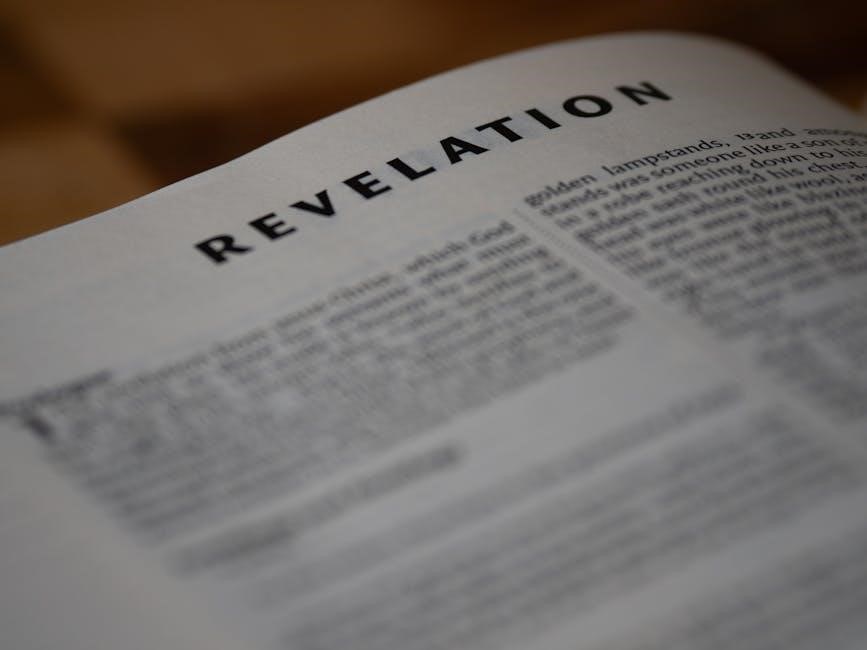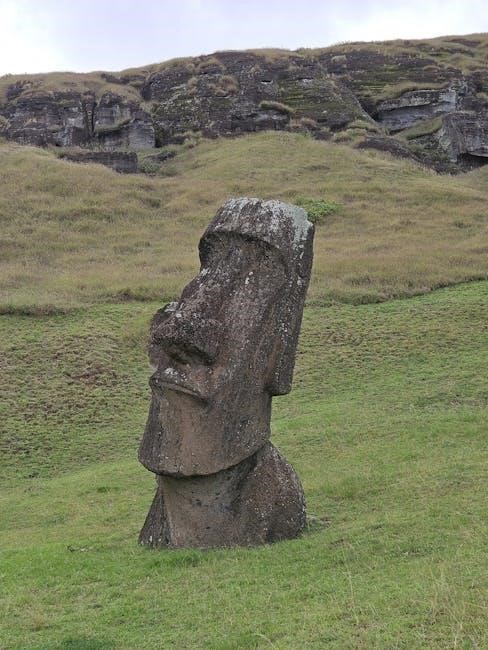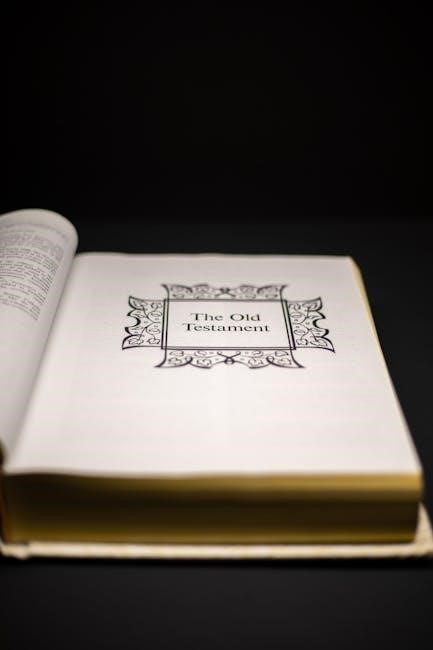The Bible as History explores the historical context and archaeological confirmations of biblical narratives, offering insights into ancient civilizations and their cultural significance, shaping Western civilization’s foundation.
1.1 Overview of the Bible as a Historical Document
The Bible is a foundational historical document that chronicles events, cultures, and civilizations spanning thousands of years. It encompasses a wide range of genres, including narratives, poetry, prophecy, and wisdom literature. As a historical text, it provides insights into the ancient Near East, including the rise and fall of empires like Egypt, Babylon, and Assyria. Archaeological discoveries, such as the Hittite civilization and the Pool of Siloam, have validated many biblical accounts. The Bible’s historical framework is organized chronologically, from creation to the early Christian church, offering a linear perspective of God’s interaction with humanity. Its influence on Western law, culture, and religion remains unparalleled.
1.2 The Significance of Studying the Bible as History
Studying the Bible as history provides profound insights into the development of Western civilization, law, and culture. It reveals the cultural and theological contexts of ancient societies, shaping modern religious and ethical frameworks. The Bible’s historical narratives offer a unique perspective on human experiences, divine interaction, and moral guidance. By examining its historical accuracy and archaeological validations, readers gain a deeper understanding of its authenticity and relevance. This study bridges theology with history, illuminating the Bible’s enduring influence on global traditions and its role in forming societal structures. It remains a vital resource for comprehending the roots of many contemporary beliefs and practices.

Archaeological Evidence Confirming Biblical History
Archaeological discoveries, such as the Hittite civilization, King David’s existence, and the Pool of Siloam, confirm biblical narratives, linking them to historical events and ancient cultures, providing tangible evidence.
2.1 The Discovery of the Hittite Civilization
The discovery of the Hittite civilization in the early 20th century provided significant archaeological confirmation of biblical history. The Hittites, mentioned in the Bible as enemies of the Israelites, were long considered mythical until excavations in modern-day Turkey uncovered their capital, Hattusa. Inscriptions and artifacts revealed a powerful empire that flourished around 1600–1178 BCE, aligning with biblical accounts of their interactions with the Israelites. This finding validated the Bible’s historical reliability, demonstrating that even seemingly obscure references in Scripture often have tangible roots in ancient history. The Hittites’ existence bridges biblical narratives with the broader ancient Near Eastern context.
2.2 The Confirmation of King David’s Existence
The discovery of the Tel Dan Inscription in 1993 provided the first non-biblical confirmation of King David’s existence. This ancient stone slab, dated to the 9th century BCE, mentions the “House of David,” referring to the Judean dynasty. Archaeological finds like this validate biblical accounts of David’s reign, which is pivotal in Israel’s history. The Bible portrays David as a unifying figure, establishing Jerusalem as the capital and center of worship. These findings bridge the gap between biblical narrative and historical evidence, affirming the reliability of the Bible’s account of David’s reign and its enduring impact on Jewish and Christian traditions.
2.3 Archaeological Finds Related to the Exodus
Archaeological discoveries have shed light on the Exodus narrative, though direct evidence remains elusive. Excavations at sites like Pi-Ramesses and Kadesh-Barnea provide insights into the presence of Semitic peoples in Egypt during the New Kingdom period. The Ipuwer Papyrus describes chaos in Egypt, mirroring the plagues described in Exodus. While debates persist, these findings suggest a historical basis for the Exodus story, aligning with the Bible’s account of Israel’s liberation from Egypt. Such discoveries enhance our understanding of the Exodus as a pivotal event in biblical history, shaping the identity of the Israelites and their faith.

2.4 The Pool of Siloam and Its Biblical Significance
The Pool of Siloam, discovered in 2004, is a significant archaeological find confirming biblical accounts. Located in Jerusalem, it aligns with descriptions in the New Testament, particularly John 9:1-7, where Jesus heals a blind man. This discovery validates the Gospel’s historical accuracy, as the pool’s existence and purpose match biblical narratives. The pool was a central site for Jewish ritual purification, dating back to the Second Temple period. Its uncovering provides tangible evidence of Jerusalem’s ancient landscape, bridging the gap between scripture and history. This find underscores the Bible’s reliability as a historical source, enhancing our understanding of ancient Jewish practices and New Testament events.
2.5 The Taylor Prism and the Assyrian Empire
The Taylor Prism, an ancient Assyrian artifact, provides significant historical evidence supporting biblical accounts. Discovered in 1830, it details the military campaigns of Assyrian King Tiglath-Pileser III, including interactions with Israel, as recorded in 2 Kings 15:29 and 16:7-9. This prism confirms the Bible’s historical accuracy regarding Assyrian involvement in Israel’s history. The prism’s inscriptions align with Assyrian records, validating the biblical narrative of Israel’s subjugation and deportation. This archaeological find bridges the gap between Assyrian history and biblical accounts, reinforcing the credibility of the Bible as a historical source. It highlights the Assyrian Empire’s role in shaping the ancient Near East and its impact on Israelite history.
2.6 The Cyrus Cylinder and the Return from Exile
The Cyrus Cylinder, discovered in 1879, is a pivotal artifact confirming the Bible’s historical accuracy. It records Cyrus the Great’s decree allowing the Jews to return to Jerusalem after Babylonian exile, as described in Ezra 1:1-4 and 6:1-5. This Persian Empire document aligns with biblical accounts of the restoration of Jerusalem and the rebuilding of the Temple. The cylinder highlights Cyrus’s policy of religious tolerance, enabling the Israelites to revive their worship and culture. Archaeologically, it validates the biblical narrative of the post-exilic period, demonstrating the Bible’s reliability as a historical source and its connection to wider ancient Near Eastern history.

Historical Context of the Bible
The Bible is deeply rooted in the history of the ancient Near East, reflecting interactions with civilizations like Egypt, Babylon, Persia, and Rome, shaping its narratives and cultural context.
3.1 The Ancient Near East and Its Cultures
The Ancient Near East was a cradle of civilizations, including Egyptians, Phoenicians, Hittites, Sumerians, and Akkadians, each contributing to advancements in governance, writing, and trade. These cultures interacted dynamically, influencing one another through conquests, alliances, and cultural exchanges. Their achievements, such as cuneiform, hieroglyphs, and legal codes, laid the groundwork for Western civilization. The Bible reflects this rich historical tapestry, with narratives often set against the backdrop of these ancient societies. Understanding these cultures provides essential context for interpreting biblical accounts, revealing how they shaped the theological and historical themes of the text.
3;2 The Role of Egypt in Biblical History
Egypt played a pivotal role in biblical history, serving as a refuge and a backdrop for significant events. The Israelites’ sojourn in Egypt, their oppression, and the miraculous Exodus are central narratives. Egyptian culture and religion influenced the Israelites, shaping their identity and traditions. Archaeological evidence, such as records of Semitic populations in Egypt, corroborates these accounts. The Exodus itself is a defining moment in biblical history, showcasing divine intervention and setting the stage for the covenant at Sinai. Egypt’s interactions with the Israelites highlight its enduring significance in shaping the theological and historical foundation of the Bible.
3.3 The Babylonian and Persian Empires
The Babylonian and Persian Empires played crucial roles in shaping biblical history. Babylon’s rise to power led to the conquest of Judah, culminating in the destruction of Jerusalem and the Temple in 586 BCE; This period of exile profoundly influenced Israel’s religious and cultural identity. The Persian Empire, under Cyrus the Great, later permitted the Jews to return to Jerusalem, rebuilding the Temple and restoring their religious practices. Archaeological evidence, such as the Cyrus Cylinder, corroborates these events, highlighting the empires’ significance in the biblical narrative. Their rule shaped the theological and historical landscape of the Bible, emphasizing themes of exile, restoration, and divine providence.
3.4 The Roman Empire and the New Testament
The Roman Empire’s influence during the 1st century CE provides the historical backdrop for the New Testament. Jesus’ life and ministry occurred under Roman rule, with events like the Crucifixion reflecting the empire’s judicial practices. The Pax Romana facilitated the spread of Christianity, as Roman roads and governance enabled early Christians to disseminate their teachings. Archaeological findings, such as the Pontius Pilate inscription, confirm the Bible’s historical context. The Roman Empire’s political and cultural dominance shaped the setting for the Gospels and the early church, bridging the ancient world and the rise of Christianity, and highlighting the interplay between imperial power and religious transformation.

The Bible’s Historical Timeline
The Bible’s timeline spans from creation to the early church, detailing major events like the Exodus, kingdoms of Israel and Judah, and the life of Jesus Christ.
4.1 From Creation to the Patriarchs
The biblical account begins with creation, describing God’s formation of the world and humanity. The early chapters detail the first humans, Adam and Eve, and the subsequent generations. The story of Noah and the Flood marks a pivotal moment, resetting humanity. Following this, the narrative shifts to the Patriarchs—Abraham, Isaac, and Jacob—whose lives laid the foundation for Israel’s identity. Abraham’s call to Canaan and his covenant with God are central themes, establishing a divine promise of land and descendants. These events set the stage for the unfolding of Israel’s history, emphasizing faith, obedience, and God’s providence in shaping His people.
4.2 The Period of the Judges
The period of the Judges follows the Patriarchal era, spanning several centuries. This time is marked by a cyclical pattern of sin, oppression, and deliverance, as Israel repeatedly turned away from God. Judges, divinely appointed leaders, arose to rescue the people, including figures like Othniel, Ehud, and Samson. Deborah, a prophet and judge, exemplifies leadership during this era. The judges maintained order and guided Israel, though the people’s recurring disobedience highlighted their spiritual struggles. This period concluded with the demand for a monarchy, transitioning Israel into a new phase of governance under kings like Saul and David.
4.3 The Kingdoms of Israel and Judah
The kingdoms of Israel and Judah emerged after the period of the judges, with Saul as the first king. David united the tribes, establishing Jerusalem as the capital, while Solomon expanded the kingdom and built the Temple. After Solomon’s reign, the kingdom divided into Israel (north) and Judah (south). Israel fell to Assyria in 722 BCE, while Judah, despite its struggles, survived until Babylonian conquest in 586 BCE. This era saw key figures like Elijah, Elisha, and Isaiah, who emphasized faithfulness to God; The kingdoms’ histories highlight themes of unity, division, and divine judgment, shaping Israel’s identity and legacy.
4.4 The Exile and Restoration
The Exile and Restoration mark a pivotal era in biblical history, beginning with the Babylonian conquest of Judah in 586 BCE, leading to the destruction of Jerusalem and the Temple. The Israelites were forcibly relocated to Babylon, where they endured a 70-year exile. This period prompted profound theological reflection, as recorded in the prophetic writings of Ezekiel and Daniel. The Persian Empire’s rise under Cyrus the Great brought an end to the exile, with Cyrus’s decree allowing the Jews to return and rebuild the Temple in Jerusalem. This restoration, supported by archaeological evidence like the Cyrus Cylinder, signifies divine providence and the enduring covenant between God and His people.
4.5 The Intertestamental Period
The Intertestamental Period, spanning approximately 400 years between the Old and New Testaments, was a time of significant cultural, religious, and political transformation. Following the Babylonian exile and Persian rule, Alexander the Great’s conquests brought Greek dominance, influencing Jewish culture and sparking tensions over Hellenization. The Maccabean Revolt (167–160 BCE) restored Jewish independence, leading to the Hasmonean dynasty. This era saw the rise of religious groups like the Pharisees and Sadducees, shaping Jewish thought. The period concluded with Roman rule, setting the stage for the New Testament’s narrative. Archaeological and historical records, such as the Maccabean coins and texts, confirm this pivotal transition in Jewish history.
4.6 The Life of Jesus and the Early Church
The life of Jesus Christ, as recorded in the New Testament, marks a pivotal moment in history, bridging the Old Testament and the rise of Christianity. Jesus’ teachings, miracles, death, and resurrection form the core of the Gospels, while the Acts of the Apostles details the early church’s growth. Archaeological evidence, such as Roman records of Pontius Pilate and Emperor Tiberius, supports the historical context of Jesus’ ministry. The early church, led by figures like Peter and Paul, spread Christianity across the Mediterranean, establishing communities that shaped Western religious and cultural identity. This period is foundational to understanding the transition from Judaism to Christianity.

Key Figures in Biblical History
Key figures in biblical history, such as Abraham, Moses, David, and Jesus, are central to shaping religious, cultural, and historical narratives, influencing Western civilization’s development and identity.
5.1 Abraham: The Father of Faith
Abraham, known as the “Father of Faith,” is a pivotal figure in biblical history, called by God to leave Ur of the Chaldees and journey to Canaan. His unwavering trust in God’s promises established him as a model of faith, central to both Old and New Testament narratives. Archaeological findings, such as references to ancient Near Eastern cultures, support the historical context of Abraham’s life. His covenant with God, marked by circumcision, formed the foundation of Israel’s identity. Abraham’s story, spanning generations, highlights themes of obedience, divine promise, and the birth of a nation, making him a cornerstone of biblical and cultural heritage.
5;2 Moses and the Exodus
Moses is a central figure in biblical history, leading the Israelites out of Egyptian bondage during the Exodus. This event, marked by miracles like the parting of the Red Sea, shaped Israel’s identity and faith. Archaeological evidence, such as the Ipuwer Papyrus, supports the historical context of the Exodus. Moses received the Ten Commandments on Mount Sinai, establishing a covenant between God and His people. His leadership and the Exodus narrative are foundational to Jewish, Christian, and Islamic traditions, emphasizing themes of deliverance, divine guidance, and the formation of a covenant community. This event remains a pivotal moment in biblical and cultural history.
5.3 King David and the Kingdom of Israel
King David, a pivotal figure in biblical history, ruled Israel from circa 1010 to 970 BCE. He united the tribes of Israel, establishing Jerusalem as the capital and strengthening the monarchy. David’s reign marked a golden age, characterized by military conquests, cultural prosperity, and religious renewal. He promoted the arts, particularly music and worship, and his leadership solidified Israel’s identity. Archaeological evidence, such as the Tel Dan Inscription, confirms his historical existence. David’s legacy extends through his dynasty, which became a symbol of hope and divine promise, culminating in the messianic expectations linked to Jesus Christ. His reign remains central to Israel’s historical narrative and cultural memory.
5.4 Jesus Christ: The Central Figure of the New Testament
Jesus Christ is the central figure of the New Testament, whose life, teachings, death, and resurrection form the cornerstone of Christian faith. Born circa 4 BCE and crucified around 33 CE, Jesus’ ministry emphasized love, forgiveness, and the kingdom of God. His teachings, recorded in the Gospels, reshaped Jewish traditions and laid the foundation for Christianity. Archaeological and historical records, such as Roman and Jewish texts, corroborate his existence and influence. The New Testament portrays Jesus as the Messiah, fulfilling Old Testament prophecies, and his resurrection as a divine act of salvation. His legacy transformed the ancient world, shaping the course of Western history and inspiring countless followers across centuries.

The Bible as a Source of Historical Insight
The Bible offers insights into ancient cultures, law, and science, while its unique narrative style and concepts like covenant reveal its historical depth and influence.
6.1 The Bible’s Unique Narrative Style
The Bible’s narrative style is distinctive, blending history, poetry, and prophecy to convey its message. Its chronological structure provides a linear view of human history, from creation to redemption. The text emphasizes divine interaction with humanity, shaping its stories around themes of covenant, faith, and redemption. This unique approach sets it apart from other ancient historical accounts, offering moral and spiritual insights alongside historical events. The narrative’s focus on character development and ethical dilemmas adds depth, making it a rich source for understanding human nature and divine purpose. Its influence on Western literature and art is profound, reflecting its enduring relevance as a historical and spiritual text.
6.2 The Role of Prophecy in Biblical History
Prophecy plays a central role in biblical history, serving as both a divine message and a historical anchor. Biblical prophets like Isaiah, Jeremiah, and Ezekiel delivered God’s messages, often foretelling future events. These prophecies frequently intertwined with historical happenings, such as the fall of Jerusalem or the return from exile, providing a theological framework for understanding these events. Prophecy also emphasized moral accountability, urging people to align with God’s will. Many prophecies were fulfilled historically, such as the destruction of the Temple in 586 BCE, validating the Bible’s credibility. This unique blend of prediction and historical fulfillment underscores the Bible’s claim to divine authority and purpose.
6.3 The Concept of Covenant in the Bible
The concept of covenant is central to biblical history, representing a divine agreement between God and humanity. Key covenants include those with Noah, Abraham, Moses, and David, each establishing specific promises and responsibilities. These covenants formed the foundation of Israel’s identity and relationship with God, shaping their legal, moral, and cultural frameworks. The Mosaic Covenant, for instance, introduced the Ten Commandments, influencing Western legal traditions. The covenant theme evolves throughout the Bible, culminating in the New Testament’s portrayal of Jesus as the fulfillment of God’s promises. This concept underscores the Bible’s historical and theological unity, emphasizing faithfulness, obedience, and divine grace.

Challenges to the Bible’s Historical Accuracy
Scholars debate the Bible’s historical accuracy, citing archaeological discrepancies, inconsistent narratives, and mythical elements like the Flood, challenging its literal interpretation and factual reliability.
7.1 Debates Over the Historicity of the Flood
The historicity of the Flood narrative in Genesis remains a contentious topic among scholars. While some interpret it as a mythical allegory, others seek archaeological evidence to confirm its occurrence. Geological studies and flood legends from ancient Mesopotamia, such as the Epic of Gilgamesh, draw parallels with the biblical account. However, no conclusive evidence of a global flood has been found. Scholars debate whether the Flood was a local event or a metaphor for human sin and redemption. The lack of specific archaeological proof leaves the question open, with interpretations varying widely among scientists, theologians, and historians.
7.2 Questions Surrounding the Conquest of Canaan
The Conquest of Canaan, as described in the Bible, has sparked significant debate among historians and archaeologists. While the biblical account portrays a swift and decisive takeover by the Israelites, archaeological evidence suggests a more gradual process. Excavations at sites like Jericho and Ai have not fully corroborated the destruction described in Scripture. Some scholars argue for a peaceful migration or cultural shift rather than a military conquest. The discovery of the Pool of Siloam supports biblical accuracy in some areas, but the lack of widespread evidence for the Conquest raises questions about its historicity. This discrepancy fuels ongoing debates about the interpretation of biblical narratives.
7.3 The Historical Jesus and the Gospels
The Gospels provide the primary accounts of Jesus Christ’s life, teachings, death, and resurrection. While they are central to Christian faith, debates persist about their historical accuracy. Archaeological evidence, such as the Pool of Siloam, supports some biblical details, but the lack of non-biblical records about Jesus challenges historians. The Gospels’ narrative style and theological purpose often blur the line between history and interpretation. Scholars debate how to distinguish the historical Jesus from the theological one, raising questions about the reliability of the Gospels as purely historical sources. Despite these debates, the Gospels remain a cornerstone of Christian belief and Western historical influence.

The Bible’s Influence on Western History
The Bible profoundly shaped Western civilization, influencing law, art, literature, and moral values. Its teachings inspired movements like the Renaissance and Enlightenment, leaving an enduring legacy.
8.1 The Bible’s Role in the Development of Law
The Bible significantly influenced the development of law, particularly in Western societies. Biblical teachings, such as the Ten Commandments, provided moral frameworks that shaped legal codes. The concept of “an eye for an eye” from Leviticus introduced retributive justice, later evolving into more compassionate principles. The Proverbs and New Testament emphasized justice, mercy, and fairness, impacting legal ethics. Biblical principles were incorporated into early legal systems, forming the basis of modern law. The Bible’s emphasis on justice, morality, and human dignity continues to inspire legal reforms, making it a foundational text in the evolution of law and governance.

8.2 The Bible and the Rise of Science
The Bible played a significant role in the rise of science by fostering a worldview that valued order, rationality, and the study of creation. Early scientists, such as Francis Bacon and Isaac Newton, drew inspiration from biblical concepts of a coherent, purposeful universe. The Bible’s emphasis on human stewardship of the Earth encouraged exploration and scientific inquiry. Christian theologians and scholars often supported scientific endeavors, viewing them as a way to understand God’s creation. This theological framework contributed to the development of modern scientific methods and the rise of prominent scientists who saw their work as a form of worship and service to God.
8.3 The Bible’s Impact on Art and Literature
The Bible has profoundly influenced art and literature, inspiring countless masterpieces throughout history. From Michelangelo’s Sistine Chapel to Raphael’s biblical frescoes, religious art often draws from biblical narratives. Literature similarly reflects this influence, with works like John Milton’s Paradise Lost and Dante’s The Divine Comedy deeply rooted in biblical themes. The Bible’s stories, such as the Creation, the Flood, and the Exodus, have provided universal motifs for artists and writers. Its themes of redemption, morality, and divine intervention continue to resonate in modern literature and art, making it a timeless source of creative inspiration across cultures and centuries.
8.4 The Bible in Modern Times
In modern times, the Bible remains a significant cultural and spiritual text, influencing diverse fields. Technological advancements have made it accessible through digital platforms, apps, and online resources. Modern scholarship continues to study its historical context, with archaeological discoveries validating its accounts. The Bible’s teachings on morality and justice inspire social movements, while its stories and themes are adapted in films, music, and literature. Despite debates about its interpretation, its impact on personal faith and global ethics endures. The Bible’s relevance in contemporary society underscores its timeless appeal and enduring influence across generations and cultures.
The Bible as History validates its narratives through archaeology, cultural impact, and enduring legacy, shaping Western civilization and remaining a cornerstone of faith and historical study.
9.1 The Enduring Legacy of the Bible as History
The Bible’s legacy as a historical document is unparalleled, shaping Western civilization’s legal, cultural, and spiritual foundations. Its narratives have influenced art, literature, and societal norms, transcending religious contexts. Archaeological discoveries continue to validate its historical accuracy, reinforcing its relevance. As a source of moral and ethical guidance, the Bible remains central to global faith communities, bridging ancient and modern times. Its impact on law, education, and human rights underscores its enduring significance, ensuring its influence for future generations.